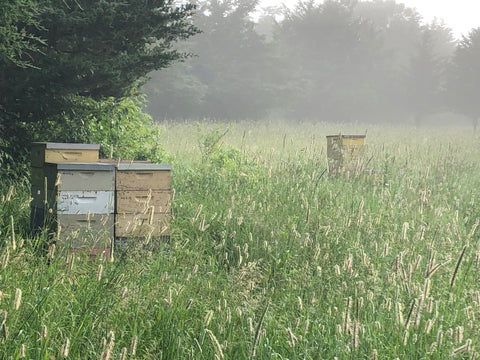
Back in the spring of 1995 I was in the kitchen of my 1905 era farmhouse after harvesting some early season honey and tasted Dandelion honey for the first time. I realized that the honey the bees make depends on the time of the season and what tree, shrub or plant is in bloom.
Each hive and box of nine combs called a "super," where the bees make surplus honey that we harvest, is then unique to that location, hive and time period.
I thought how could I make honey that was closer to what the bees actually produced in a hive each season? I realized I had to leave each super of honey intact and bottle each one separately to preserve the essence of what the bees produce. The honey would be sold as raw unheated honey too, since heat damages the delicate flavors and unique medicinal properties of honey and is unnecessary. The idea of Single Source Honey was born at that moment, and the definition eventually became:
~~~~~~~~~~~~~~~~~~~~~~~~~~~~~~~~~~~~~~~~~~~~~~~~~~~~~~~~~~~~~
Raw Honey produced from a Single Hive from a Single Location and during a Single Time Period.
~~~~~~~~~~~~~~~~~~~~~~~~~~~~~~~~~~~~~~~~~~~~~~~~~~~~~~~~~~~~~
Raw Honey produced from a Single Hive from a Single Location and during a Single Time Period.
~~~~~~~~~~~~~~~~~~~~~~~~~~~~~~~~~~~~~~~~~~~~~~~~~~~~~~~~~~~~~
The label on the each of the jars has the location printed where the hive was located between May and September in Minnesota. The hive number, like 712 followed by a letter A-Z, signifies if it was the first 36 pound super made probably in May, or maybe it was a more uncommon F box made in the fall. The time period is noted on the top label for the main flower like Basswood or Dutch Clover that was in bloom when the bees filled the combs with nectar. Sometimes it's a collection of flowers like Summer Blossom or Prairie Flower.
This means we only extract and keep intact the nine six-pound combs of honey in each super. Often times that honey was collected during a short two-week period during our Minnesota spring, summer and fall. Each jar then is a floral snapshot of some time and some place in Minnesota.
This means we only extract and keep intact the nine six-pound combs of honey in each super. Often times that honey was collected during a short two-week period during our Minnesota spring, summer and fall. Each jar then is a floral snapshot of some time and some place in Minnesota.
Because each hive of bees is unique in size and strength and each of our 18 locations features different soil, weather and flora we collect and offer a plethora of flavors that come the variety of honey our bees make. Nothing is added; no flavors or infusions. Just raw honey direct from the hive made in micro-batches by a 27-year-old artisanal process that no one has dared copy because of the insane amount of time and effort to keep the honey separate and package it with specific information to its origins.
We produce about 1200 of those 36 pound supers each season. While other Beekeepers blend most of their honey into one big tank that takes much less time, we spend a crazy amount of effort extracting each one at a time. But we think it’s worth it, and are confident you can taste the difference in our Single Source Honeys. www.amesfarm.com
We produce about 1200 of those 36 pound supers each season. While other Beekeepers blend most of their honey into one big tank that takes much less time, we spend a crazy amount of effort extracting each one at a time. But we think it’s worth it, and are confident you can taste the difference in our Single Source Honeys. www.amesfarm.com



